Methods Of Separation Of Substances Under Dry Conditions
Methods Of Separation Of Substances Under Dry Conditions
Different methods are used for separating different substances that are mixed together such as handpicking, threshing, winnowing and sieving.
Threshing
Grains or seeds of plants like rice and wheat serve as sources of food. The flour (atta) that is used for making chapattis is made from wheat grains. After these crops have been harvested or cut, the grains need to be separated from the stalks (the dried stems). This is done by threshing.
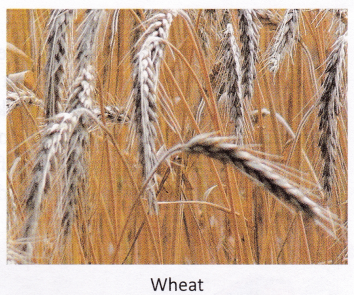 The process of beating harvested crops to separate the grains from the stalks is called threshing. It is done manually (by hand) or with the help of machines. Manual threshing is done by holding a pile of crop and beating it on a rock or a hard surface. This loosens and separates the grain from the stalk. Sometimes, threshing is also done by crushing the harvested stalks using bullocks.
The process of beating harvested crops to separate the grains from the stalks is called threshing. It is done manually (by hand) or with the help of machines. Manual threshing is done by holding a pile of crop and beating it on a rock or a hard surface. This loosens and separates the grain from the stalk. Sometimes, threshing is also done by crushing the harvested stalks using bullocks.
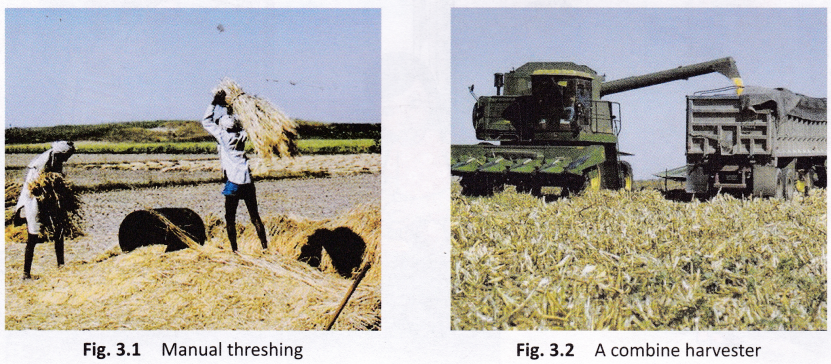
Threshing is also done with the help of machines like the combine harvester. Threshed grains may still contain seed coverings and tiny pieces of leaves or stem (collectively called chaff). These are separated by winnowing.
Winnowing
The method used to separate chaff from the grain by wind or blowing air is called winnowing.
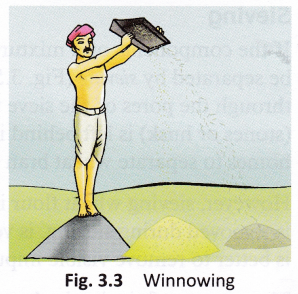 The mixture of chaff and grain is taken in a winnowing basket. The farmer stands at a higher level and lets the mixture fall to the ground. The grain, being heavier, falls almost vertically whereas the lighter chaff is carried away by the wind and forms a separate heap away from the grain. The separated chaff is used as fodder for cattle. The direction of the wind plays an important role in the process of winnowing.
The mixture of chaff and grain is taken in a winnowing basket. The farmer stands at a higher level and lets the mixture fall to the ground. The grain, being heavier, falls almost vertically whereas the lighter chaff is carried away by the wind and forms a separate heap away from the grain. The separated chaff is used as fodder for cattle. The direction of the wind plays an important role in the process of winnowing.
Activity
Aim: To understand the process of winnowing.
Materials needed: Plate, rice, tiny bits of paper, a chair and old newspapers.
Method:
1. Go to an open ground or garden and spread sheets of newspaper on the ground.
2. Take some rice mixed with bits of paper in a plate. Stand on the chair and let the mixture fall slowly by shaking the plate.
Observation: The rice grains form a separate heap from the paper bits.
Conclusion: The blowing air or wind can be used to separate lighter particles (paper bits) from heavier particles (rice grains).
Hand-picking
Rice, wheat, pulses, etc., that we buy from the market may contain impurities (unwanted or harmful particles) in the form of small stones, unwanted grains, etc. Often, these impurities look very different from the food item and can be spotted easily. The method of separation used in such a case is hand-picking.
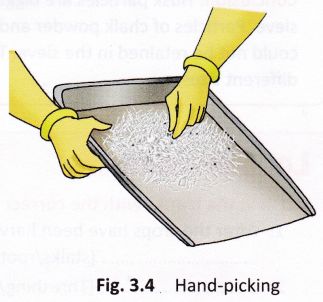 This method is preferred when
This method is preferred when
- The quantity of the mixture is small,
- The unwanted substance is present in smaller quantities, and
- The size, shape, or colour of the unwanted substance is different from that of the useful one.
Sieving
If the components of a mixture are of different sizes, they can be separated by sieving. The smaller component passes through the pores of the sieve whereas the larger component (stones or husk) is left behind in it. This method is used in some homes to separate wheat bran (the bigger particles) from flour.
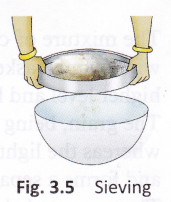 However, sieving wheat flour is not advisable as wheat bran, which is removed during sieving, is very rich in nutrients and is also a rich is better to remove visible impurities by hand picking. The process of sieving is also used to separate pebbles and stones from sand at construction sites. The stones and pebbles present in the mixture remain in the sieve and the fine sand particles pass through the holes of the sieve.
However, sieving wheat flour is not advisable as wheat bran, which is removed during sieving, is very rich in nutrients and is also a rich is better to remove visible impurities by hand picking. The process of sieving is also used to separate pebbles and stones from sand at construction sites. The stones and pebbles present in the mixture remain in the sieve and the fine sand particles pass through the holes of the sieve.
Activity
Aim: To understand sieving
Materials needed: Flour, powdered chalk, old newspaper, and a sieve
Method:
1. Sieve the flour on the newspaper to separate husk or any impurities.
2. Take a small amount of flour and mix it with fine chalk powder.
3. Sieve the mixture. Can chalk powder be separated from flour?
Observation: Husk and other impurities could be separated from the flour, but chalk powder could not be separated.
Conclusion: Husk particles are bigger than flour particles; so they are retained in the sieve. Particles of chalk powder and flour do not differ much in size; so chalk powder could not be retained in the sieve. Thus, sieving can be used to separate particles of different sizes.
The post Methods Of Separation Of Substances Under Dry Conditions appeared first on A Plus Topper.
from A Plus Topper
via Learning Made Simple 360
*Note that these contents are Autoblogged from A Plus Topper and cannot be edited.
Join the conversation